Image Processing and Support Vector Machine (SVM) for Classifying Environmental Stress Symptoms of Pepper Seedlings Grown in a Plant Factory
Abstract
:1. Introduction
2. Materials and Methods
2.1. Pepper Seedling Growth Condition and Plant Factory
2.2. Image Acquisition
2.3. Image Processing
2.4. Feature Selection
2.5. SVM Classification Model
2.6. Model Performance
3. Results
3.1. Selected Stress Symptoms Features
3.2. Stress Classification Using SVM Model
4. Discussion
5. Conclusions
Author Contributions
Funding
Data Availability Statement
Conflicts of Interest
References
- Zhang, H.; Zhu, J.; Gong, Z.; Zhu, J.K. Abiotic stress responses in plants. Nat. Rev. Genet. 2022, 23, 104–119. [Google Scholar] [CrossRef] [PubMed]
- Gull, A.; Lone, A.A.; Wani, N.U.I. Biotic and abiotic stresses in plants. In Abiotic and Biotic Stress in Plants; Bosco de Oliveira, A., Ed.; IntechOpen: London, UK, 2019; pp. 1–6. [Google Scholar]
- He, M.; He, C.Q.; Ding, N.Z. Abiotic stresses: General defenses of land plants and chances for engineering multi-stress tolerance. Front. Plant Sci. 2018, 9, 1771. [Google Scholar] [CrossRef] [PubMed]
- Singh, H.; Sethi, S.; Kaushik, P.; Fulford, A. Grafting vegetables for mitigating environmental stresses under climate change: A review. J. Water Clim. Chang. 2020, 11, 1784–1797. [Google Scholar] [CrossRef]
- Sharma, J.; Upadhyay, A.K.; Adsule, P.G.; Sawant, S.D.; Sharma, A.K.; Satisha, J.; Yadav, D.S.; Ramteke, S.D. Effect of climate change on grape and its value-added products. In Climate-Resilient Horticulture: Adaptation and Mitigation Strategies; Springer: Dordrecht, The Netherlands, 2013; pp. 67–80. [Google Scholar]
- Gao, Z.; Luo, Z.; Zhang, W.; Lv, Z.; Xu, Y. Deep learning application in plant stress imaging: A review. AgriEngineering 2020, 2, 430–446. [Google Scholar] [CrossRef]
- Araus, J.L.; Cairns, J.E. Field high-throughput phenotyping: The new crop breeding frontier. Trends Plant Sci. 2014, 19, 52–61. [Google Scholar] [CrossRef]
- Lowe, A.; Harrison, N.; French, A.P. Hyperspectral image analysis techniques for the detection and classification of the early onset of plant disease and stress. Plant Methods 2017, 13, 80. [Google Scholar] [CrossRef]
- Behmann, J.; Steinrücken, J.; Plümer, L. Detection of early plant stress responses in hyperspectral images. ISPRS J. Photogramm. Remote Sens. 2014, 93, 98–111. [Google Scholar] [CrossRef]
- Kuska, M.; Wahabzada, M.; Leucker, M.; Dehne, H.W.; Kersting, K.; Oerke, E.C.; Steiner, U.; Mahlein, A.K. Hyperspectral phenotyping on the microscopic scale: Towards automated characterization of plant-pathogen interactions. Plant Methods 2015, 11, 28. [Google Scholar] [CrossRef]
- Singh, A.; Ganapathysubramanian, B.; Singh, A.K.; Sarkar, S. Machine learning for high-throughput stress phenotyping in plants. Trends Plant Sci. 2016, 21, 110–124. [Google Scholar] [CrossRef]
- Naik, H.S.; Zhang, J.; Lofquist, A.; Assefa, T.; Sarkar, S.; Ackerman, D.; Singh, A.; Singh, A.K.; Ganapathysubramanian, B. A real-time phenotyping framework using machine learning for plant stress severity rating in soybean. Plant Methods 2017, 13, 23. [Google Scholar] [CrossRef]
- Chemura, A.; Mutanga, O.; Sibanda, M.; Chidoko, P. Machine learning prediction of coffee rust severity on leaves using spectroradiometer data. Trop. Plant Pathol. 2018, 43, 117–127. [Google Scholar] [CrossRef]
- Wicaksono, Y.; Wahono, R.; Suhartono, V. Color and texture feature extraction using gabor filter-local binary patterns for image segmentation with fuzzy C-means. J. Intell. Syst. 2015, 1, 15–21. [Google Scholar]
- Mizushima, A.; Lu, R. An image segmentation method for apple sorting and grading using support vector machine and Otsu’s method. Comput. Electron. Agric. 2013, 94, 29–37. [Google Scholar] [CrossRef]
- Burgos-Artizzu, X.P.; Ribeiro, A.; Tellaeche, A.; Pajares, G.; Fernández-Quintanilla, C. Improving weed pressure assessment using digital images from an experience-based reasoning approach. Comput. Electron. Agric. 2009, 65, 176–185. [Google Scholar] [CrossRef]
- Li, Z.; Guo, R.; Li, M.; Chen, Y.; Li, G. A review of computer vision technologies for plant phenotyping. Comput. Electron. Agric. 2020, 176, 105672. [Google Scholar] [CrossRef]
- Yang, R.; Wu, Z.; Fang, W.; Zhang, H.; Wang, W.; Fu, L.; Majeed, Y.; Li, R.; Cui, Y. Detection of abnormal hydroponic lettuce leaves based on image processing and machine learning. Inf. Process. Agric. 2021, 10, 1–10. [Google Scholar] [CrossRef]
- Karadağ, K.; Tenekeci, M.E.; Taşaltın, R.; Bilgili, A. Detection of pepper fusarium disease using machine learning algorithms based on spectral reflectance. Sustain. Comput. Inform. Syst. 2020, 28, 100299. [Google Scholar] [CrossRef]
- Prasad, S.; Kumar, P.; Hazra, R.; Kumar, A. Plant Leaf Disease Detection Using Gabor Wavelet Transform. In Proceedings of the 3rd International Conference on Swarm, Evolutionary, and Memetic Computing, Bhubaneswar, India, 20–22 December 2012; Springer: Berlin/Heidelberg, Germany, 2012; pp. 1–6. [Google Scholar]
- Sun, Y.; Tong, C.; He, S.; Wang, K.; Chen, L. Identification of nitrogen, phosphorus, and potassium deficiencies based on temporal dynamics of leaf morphology and color. Sustainability 2018, 10, 762. [Google Scholar] [CrossRef]
- Latte, M.V.; Shidnal, S.; Anami, B.S. Rule based approach to determine nutrient deficiency in paddy leaf images. Int. J. Agric. Technol. 2017, 13, 227–245. [Google Scholar]
- Gammoudi, N.; Karmous, I.; Zerria, K.; Loumerem, M.; Ferchichi, A.; Nagaz, K. Efficiency of pepper seed invigoration through hydrogen peroxide priming to improve in vitro salt and drought stress tolerance. Hortic. Environ. Biotechnol. 2020, 61, 703–714. [Google Scholar] [CrossRef]
- Batiha, G.E.S.; Alqahtani, A.; Ojo, O.A.; Shaheen, H.M.; Wasef, L.; Elzeiny, M.; Ismail, M.; Shalaby, M.; Murata, T.; Zaragoza-Bastida, A.; et al. Biological properties, bioactive constituents, and pharmacokinetics of some Capsicum spp. and Capsaicinoids. Int. J. Mol. Sci. 2020, 21, 5179. [Google Scholar] [CrossRef]
- Barbero, G.F.; Ruiz, A.G.; Liazid, A.; Palma, M.; Vera, J.C.; Barroso, C.G. Evolution of total and individual Capsaicinoids in peppers during ripening of the Cayenne pepper plant (Capsicum annuum L.). Food Chem. 2014, 153, 200–206. [Google Scholar] [CrossRef]
- Shaha, R.K.; Rahman, S.; Asrul, A. Bioactive compounds in chilli peppers (Capsicum annuum L.) at various ripening (green, yellow and red) stages. Ann. Biol. Res. 2013, 4, 27–34. [Google Scholar]
- Fattori, V.; Hohmann, M.S.; Rossaneis, A.C.; Pinho-Ribeiro, F.A.; Verri, W.A., Jr. Capsaicin: Current understanding of its mechanisms and therapy of pain and other pre-clinical and clinical uses. Molecules 2016, 21, 844. [Google Scholar] [CrossRef] [PubMed]
- Liu, N.; Ji, F.; Xu, L.; He, D. Effects of LED light quality on the growth of pepper seedling in plant factory. Int. J. Agric. Biol. Eng. 2019, 12, 44–50. [Google Scholar] [CrossRef]
- Boros, I.F.; Székely, G.; Balázs, L.; Csambalik, L.; Sipos, L. Effects of LED lighting environments on lettuce (Lactuca sativa L.) in PFAL systems—A review. Sci. Hortic. 2023, 321, 112351. [Google Scholar] [CrossRef]
- Xu, Y.; Yang, M.; Cheng, F.; Liu, S.; Liang, Y. Effects of LED photoperiods and light qualities on in vitro growth and chlorophyll fluorescence of Cunninghamia lanceolata. BMC Plant Biol. 2020, 20, 269. [Google Scholar] [CrossRef] [PubMed]
- Miao, C.; Yang, S.; Xu, J.; Wang, H.; Zhang, Y.; Cui, J.; Zhang, H.; Jin, H.; Lu, P.; He, L.; et al. Effects of light intensity on growth and quality of lettuce and spinach cultivars in a plant factory. Plants 2023, 12, 3337. [Google Scholar] [CrossRef]
- An, S.; Hwang, H.; Chun, C.; Jang, Y.; Lee, H.J.; Wi, S.H.; Yeo, K.H.; Yu, I.H.; Kwack, Y. Evaluation of air temperature, photoperiod and light intensity conditions to produce cucumber scions and rootstocks in a plant factory with artificial lighting. Horticulturae 2021, 7, 102. [Google Scholar] [CrossRef]
- Yang, H.C.; Kim, Y.H.; Byun, H.J.; Choi, I.L.; Vu, N.T.; Kim, D.H.; Yoon, H.S.; Jang, D.C. Identification of appropriate light intensity and daytime temperature for cucumber (Cucumis sativus L.) seedlings in a plant factory with artificial lighting for use as grafting material. Sustainability 2023, 15, 4481. [Google Scholar] [CrossRef]
- Watanabe, W.; Maruyama, R.; Arimoto, H.; Tamada, Y. Low-cost multi-modal microscope using Raspberry Pi. Optik 2020, 212, 164713. [Google Scholar] [CrossRef]
- Islam, S.; Reza, M.N.; Chowdhury, M.; Islam, M.N.; Ali, M.; Kiraga, S.; Chung, S.O. Image processing algorithm to estimate ice-plant leaf area from RGB images under different light conditions. In Proceedings of the 2021 International Conference on Green Agro-Industry and Bioeconomy, Malang, Indonesia, 6–7 July 2021; IOP Publishing: Bristol, UK, 2021; Volume 924, p. 012013. [Google Scholar]
- Nadafzadeh, M.; Abdanan Mehdizadeh, S. Design and fabrication of an intelligent control system for determination of watering time for turfgrass plant using computer vision system and artificial neural network. Precis. Agric. 2019, 20, 857–879. [Google Scholar] [CrossRef]
- Singh, A.; Jones, S.; Ganapathysubramanian, B.; Sarkar, S.; Mueller, D.; Sandhu, K.; Nagasubramanian, K. Challenges and opportunities in machine-augmented plant stress phenotyping. Trends Plant Sci. 2020, 26, 53–69. [Google Scholar] [CrossRef] [PubMed]
- Campos, G.F.C.; Mastelini, S.M.; Aguiar, G.J.; Mantovani, R.G.; Melo, L.F.D.; Barbon, S. Machine learning hyperparameter selection for contrast limited adaptive histogram equalization. EURASIP J. Image Video Process. 2019, 2019, 59. [Google Scholar] [CrossRef]
- Abdanan Mehdizadeh, S.; Nouri, M.; Soltani Kazemi, M.; Amraei, S. Non-destructive investigation of the quality factors in citrus juice during storage using digital image processing. Iran. Food Sci. Technol. Res. J. 2017, 2, 262–272. (In Persian) [Google Scholar]
- Wu, S.G.; Bao, F.S.; Xu, E.Y.; Wang, Y.X.; Chang, Y.F.; Xiang, Q.L. A leaf recognition algorithm for plant classification using probabilistic neural network. In Proceedings of the IEEE International Symposium on Signal Processing and Information Technology, Cairo, Egypt, 15–18 December 2007. [Google Scholar]
- Shrivastava, V.K.; Pradhan, M.K. Rice plant disease classification using color features: A machine learning paradigm. J. Plant Pathol. 2021, 103, 17–26. [Google Scholar] [CrossRef]
- Rehman, T.U.; Mahmud, M.S.; Chang, Y.K.; Jin, J.; Shin, J. Current and future applications of statistical machine learning algorithms for agricultural machine vision systems. Comput. Electron. Agric. 2019, 156, 585–605. [Google Scholar] [CrossRef]
- Padmavathi, K.; Thangadurai, K. Implementation of RGB and grayscale images in plant leaves disease detection–comparative study. Indian. J. Sci. Technol. 2016, 9, 1–6. [Google Scholar] [CrossRef]
- Prakash, R.M.; Saraswathy, G.P.; Ramalakshmi, G.; Mangaleswari, K.H.; Kaviya, T. Detection of leaf diseases and classification using digital image processing. In Proceedings of the International Conference on Innovations in Information, Embedded and Communication Systems (ICIIECS), Coimbatore, India, 17–18 March 2017. [Google Scholar]
- Suttapakti, U.; Bunpeng, A. Potato leaf disease classification based on distinct color and texture feature extraction. In Proceedings of the 19th International Symposium on Communications and Information Technologies (ISCIT), Ho Chi Minh City, Vietnam, 25–27 September 2019. [Google Scholar]
- Mutlag, W.K.; Ali, S.K.; Aydam, Z.M.; Taher, B.H. Feature extraction methods: A review. In Proceedings of the Fifth International Scientific Conference of Al-Khwarizmi Society (FISCAS) 2020, Iraq, 26–27 June 2020; IOP Publishing: Bristol, UK, 2020; Volume 1591, p. 012028. [Google Scholar]
- Ferdinand, Y.; Al Maki, W.F. Broccoli leaf diseases classification using support vector machine with particle swarm optimization based on feature selection. Int. J. Adv. Intell. Inform. 2022, 8, 337–348. [Google Scholar] [CrossRef]
- Gacav, C.; Benligiray, B.; Topal, C. Greedy search for descriptive spatial face features. In Proceedings of the 2017 IEEE International Conference on Acoustics, Speech and Signal Processing (ICASSP), New Orleans, LA, USA, 5–9 March 2017; pp. 1497–1501. [Google Scholar]
- Awad, M.; Khanna, R. Support vector machines for classification. In Efficient Learning Machines: Theories, Concepts, and Applications for Engineers and System Designers; Springer: New York, NY, USA, 2015; pp. 39–66. [Google Scholar]
- ArunPriya, C.; Thanamani, A.S. A survey on species recognition system for plant classification. Int. J. Comput. Technol. Appl. 2012, 3, 868–874. [Google Scholar]
- Landge, P.S.; Patil, S.A.; Khot, D.S.; Otari, O.D.; Malavkar, U.G. Automatic Detection and Classification of Plant Disease through Image Processing. Int. J. Adv. Res. Comput. Sci. Softw. Eng. 2013, 3, 798–801. [Google Scholar]
- Miao, J.; Zhu, W. Precision–recall curve (PRC) classification trees. Evol. Intell. 2022, 15, 1545–1569. [Google Scholar] [CrossRef]
- Hussain, M.; Wajid, S.K.; Elzaart, A.; Berbar, M. A comparison of SVM kernel functions for breast cancer detection. In Proceedings of the 2011 8th International Conference on Computer Graphics, Imaging and Visualization (CGIV), Singapore, 26–29 August 2011; pp. 145–150. [Google Scholar] [CrossRef]
- Zou, K.; Ge, L.; Zhang, C.; Yuan, T.; Li, W. Broccoli seedling segmentation based on support vector machine combined with color texture features. IEEE Access 2019, 7, 168565–168574. [Google Scholar] [CrossRef]
- Story, D.; Kacira, M.; Kubota, C.; Akoglu, A.; An, L. Lettuce calcium deficiency detection with machine vision computed plant features in controlled environments. Comput. Electron. Agric. 2010, 74, 238–243. [Google Scholar] [CrossRef]
- Yang, Z.; He, W.; Mou, S.; Wang, X.; Chen, D.; Hu, X.; Chen, L.; Bai, J. Plant growth and development of pepper seedlings under different photoperiods and photon flux ratios of red and blue LEDs. Trans. Chin. Soc. Agric. Eng. 2017, 33, 173–180. [Google Scholar]
- Zhao, J.; Lu, Z.; Wang, L.; Jin, B. Plant responses to heat stress: Physiology, transcription, noncoding RNAs, and epigenetics. Int. J. Mol. Sci. 2020, 22, 117. [Google Scholar] [CrossRef]
- Nabwire, S.; Wakholi, C.; Faqeerzada, M.A.; Arief, M.A.A.; Kim, M.S.; Baek, I.; Cho, B.K. Estimation of cold stress, plant age, and number of leaves in watermelon plants using image analysis. Front. Plant Sci. 2022, 13, 847225. [Google Scholar] [CrossRef]
- Soman, K.; Sathiya, A.; Suganthi, N. Classification of stress of automobile drivers using radial basis function kernel support vector machine. In Proceedings of the International Conference on Information Communication and Embedded Systems (ICICES), Chennai, India, 27–28 February 2014. [Google Scholar]
- Marston, Z.P.; Cira, T.M.; Knight, J.F.; Mulla, D.; Alves, T.M.; Hodgson, E.W.; Ribeiro, A.V.; MacRae, I.V.; Koch, R.L. Linear support vector machine classification of plant stress from soybean aphid (Hemiptera: Aphididae) using hyperspectral reflectance. J. Econ. Entomol. 2022, 115, 1557–1563. [Google Scholar] [CrossRef]
- Anami, B.S.; Malvade, N.N.; Palaiah, S. Classification of yield affecting biotic and abiotic paddy crop stresses using field images. Inf. Process. Agric. 2020, 7, 272–285. [Google Scholar] [CrossRef]
- Phadikar, S.; Sil, J.; Das, A.K. Classification of rice leaf diseases based on morphological changes. Int. J. Inf. Electron. Eng. 2012, 2, 460–463. [Google Scholar]
- Gunawan, P.A.; Kencana, E.N.; Sari, K. Classification of rice leaf diseases using artificial neural network. In Proceedings of the Tenth International Conference and Workshop on High Dimensional Data Analysis (ICW-HDDA-X), Sanur-Bali, Indonesia, 12–15 October 2020; IOP Publishing: Bristol, UK, 2021; Volume 1722, p. 012013. [Google Scholar]
- Shah, M.P.; Singha, S.; Awate, S.P. Leaf classification using marginalized shape context and shape+ texture dual-path deep convolutional neural network. In Proceedings of the 2017 IEEE International Conference on Image Processing (ICIP), Beijing, China, 17–20 September 2017; pp. 860–864. [Google Scholar]
- Ghosh, S.; Singh, A.; Jhanjhi, N.Z.; Masud, M.; Aljahdali, S. SVM and KNN Based CNN Architectures for Plant Classification. Comput. Mater. Contin. 2022, 71, 4257–4274. [Google Scholar] [CrossRef]
- Mittal, P.; Kansal, M.; Jhajj, H.K. Combined classifier for plant classification and identification from leaf image based on visual attributes. In Proceedings of the 2018 International Conference on Intelligent Circuits and Systems (ICICS), Phagwara, India, 19–20 April 201; pp. 188–194.
- Harish, B.S.; Hedge, A.; Venkatesh, O.; Spoorthy, D.G.; Sushma, D. Classification of plant leaves using Morphological features and Zernike moments. In Proceedings of the 2013 International Conference on Advances in Computing, Communications and Informatics (ICACCI), Mysore, India, 22–25 August 2013; pp. 1827–1831. [Google Scholar]
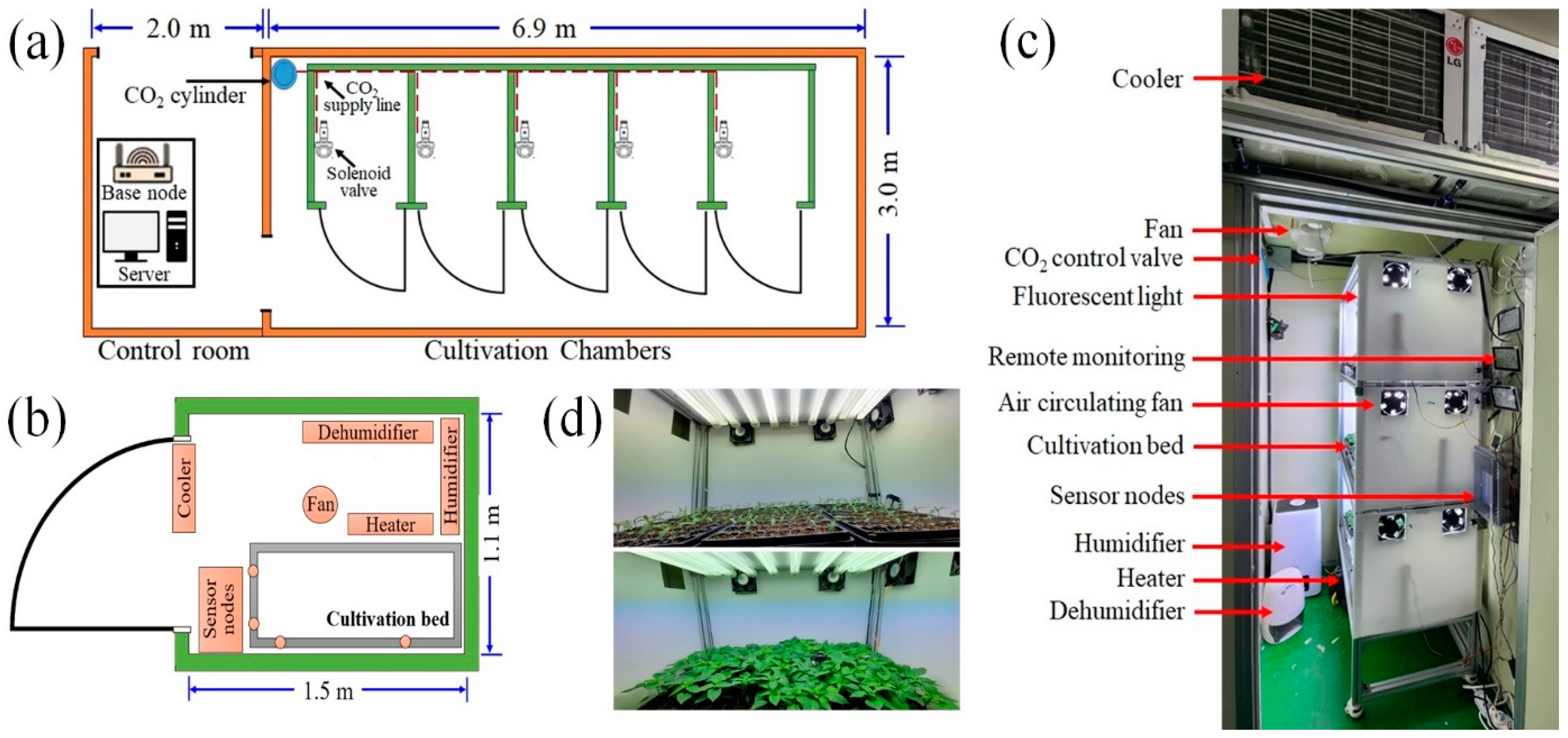
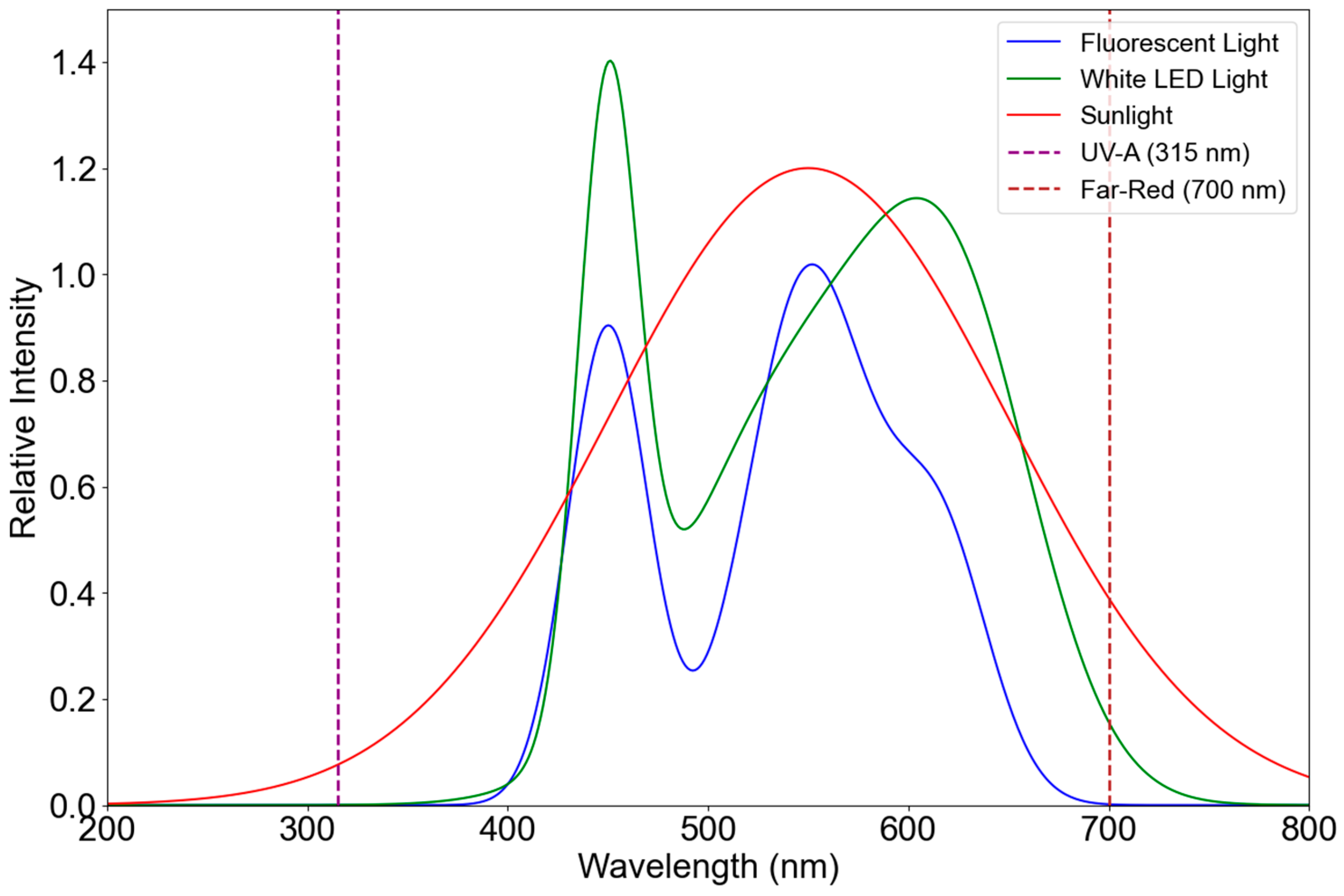
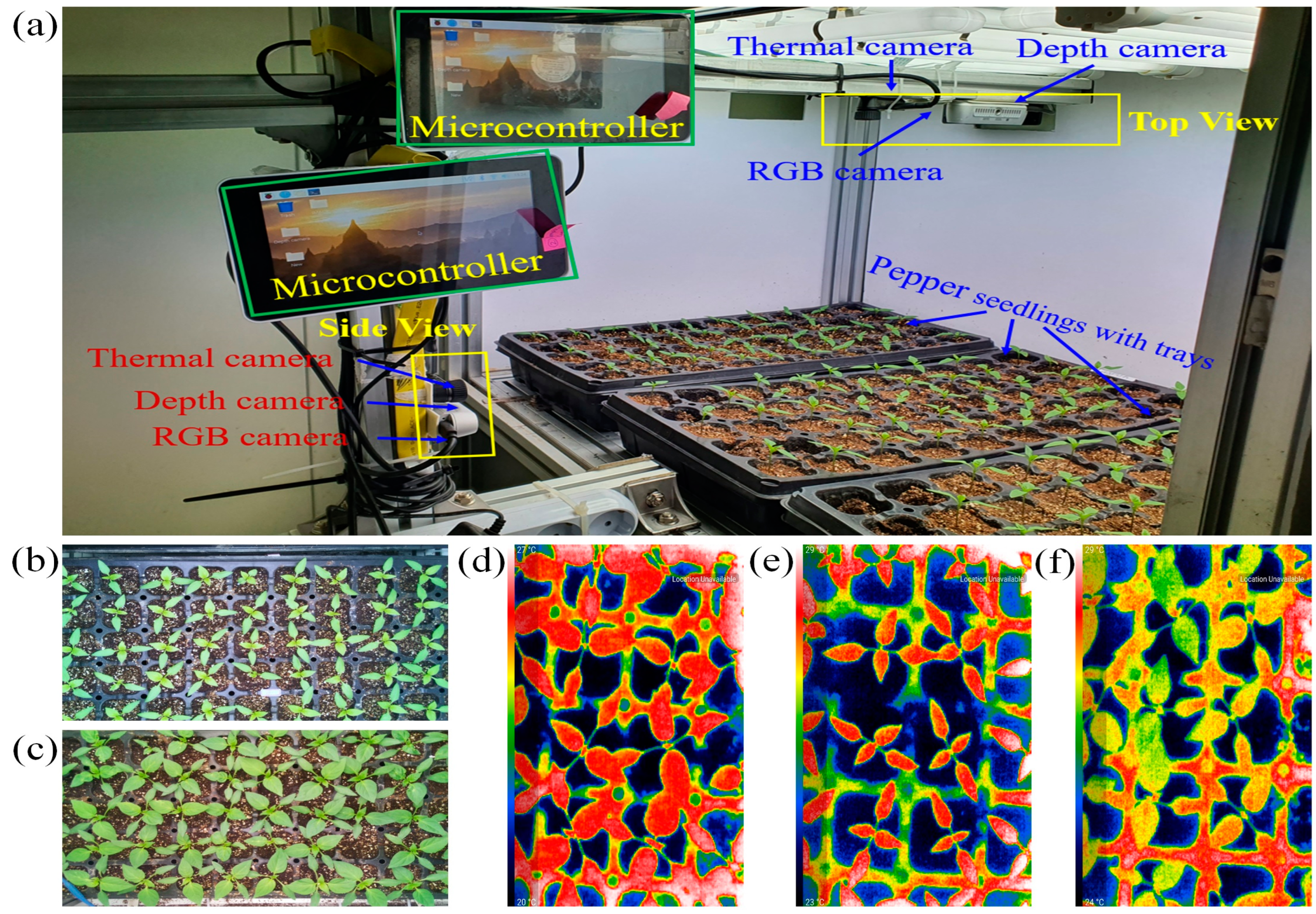
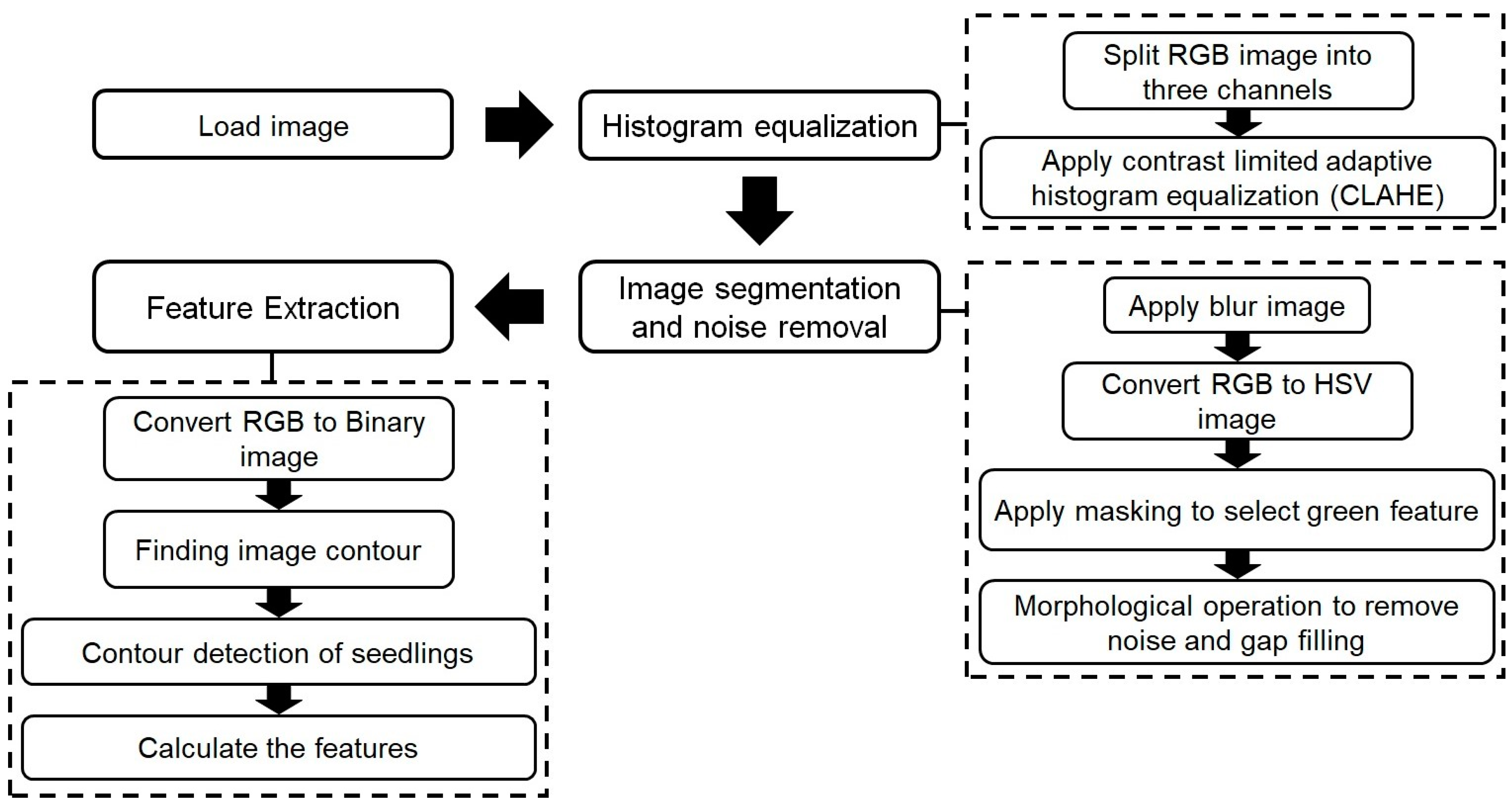


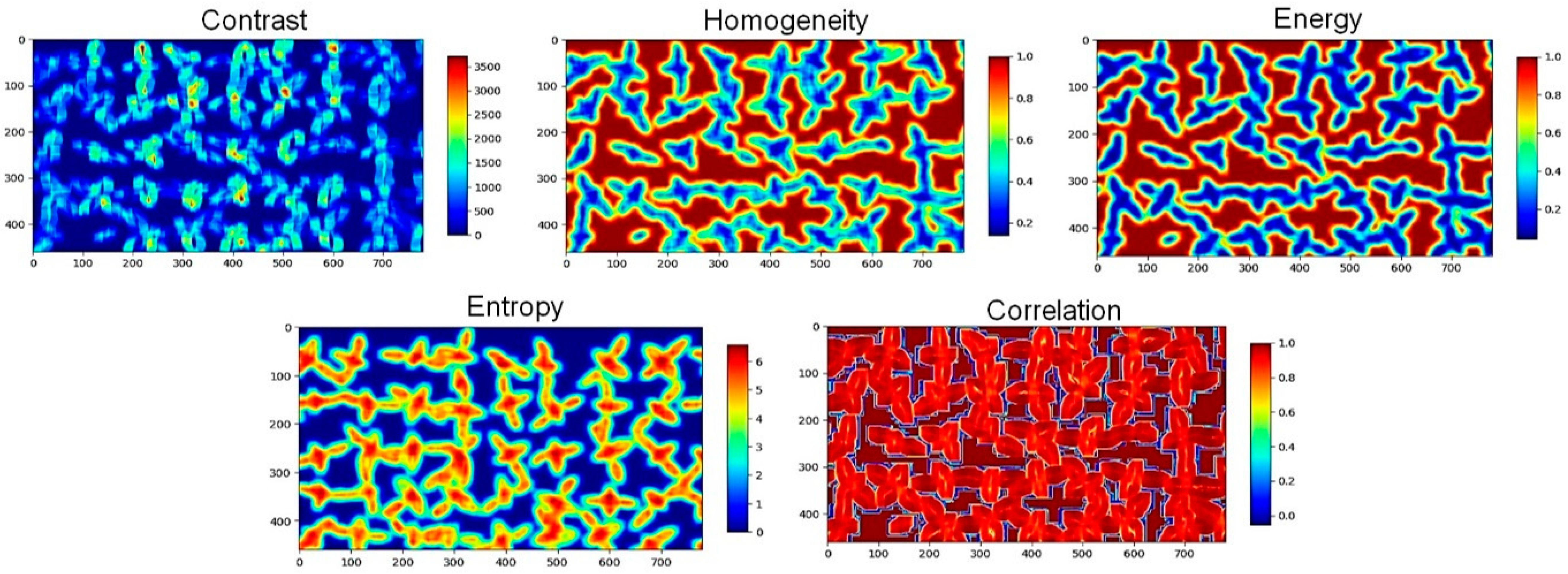
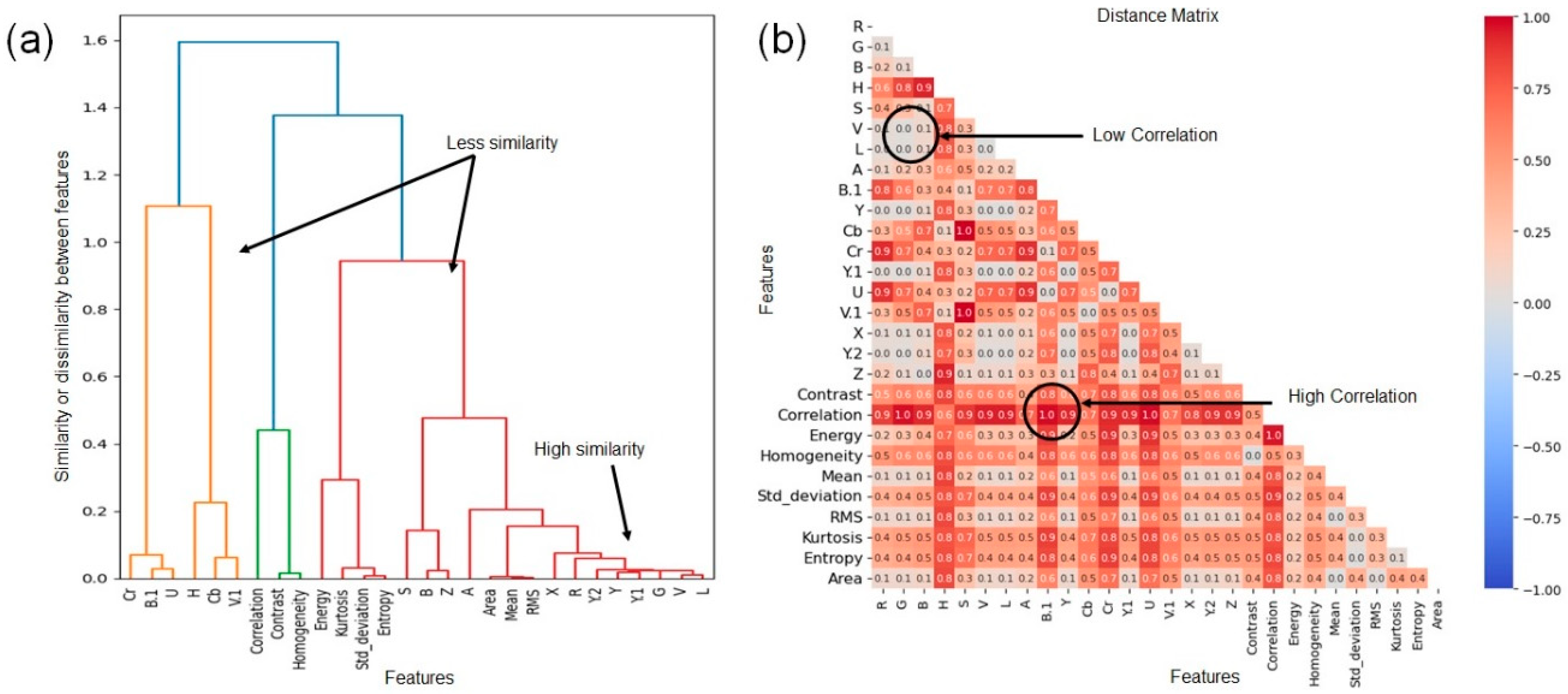
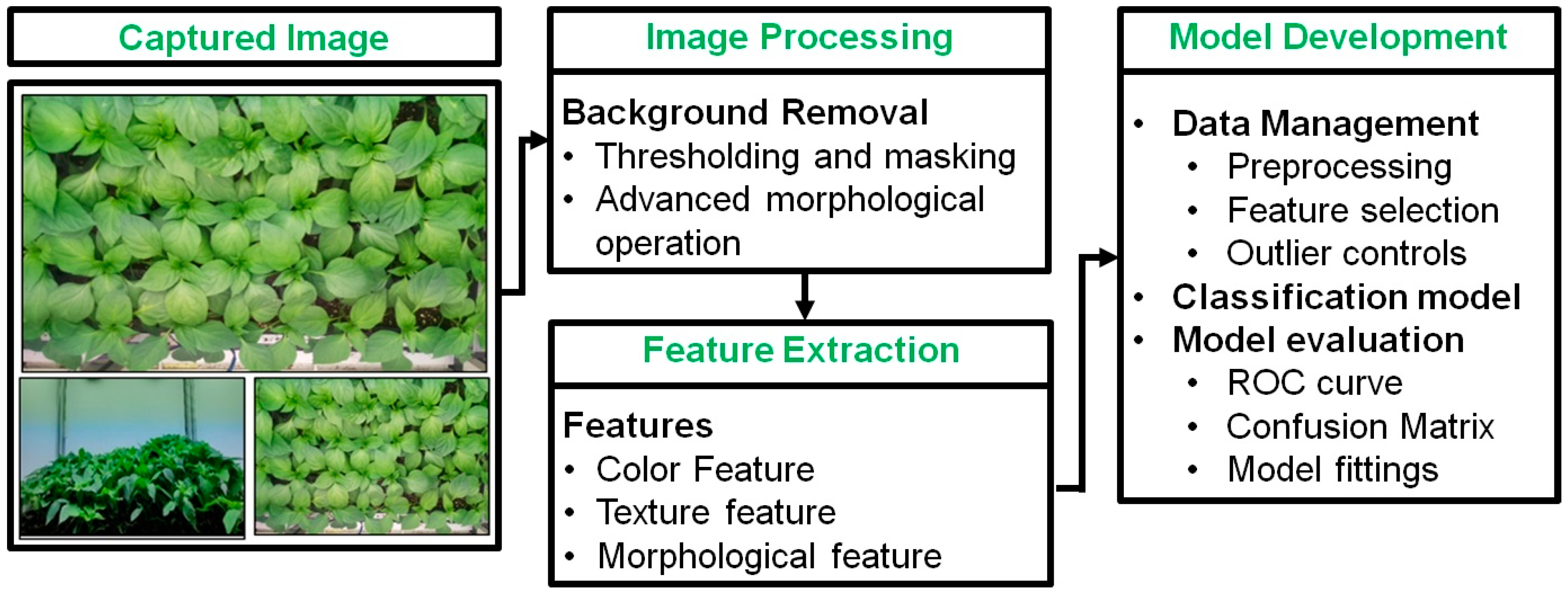

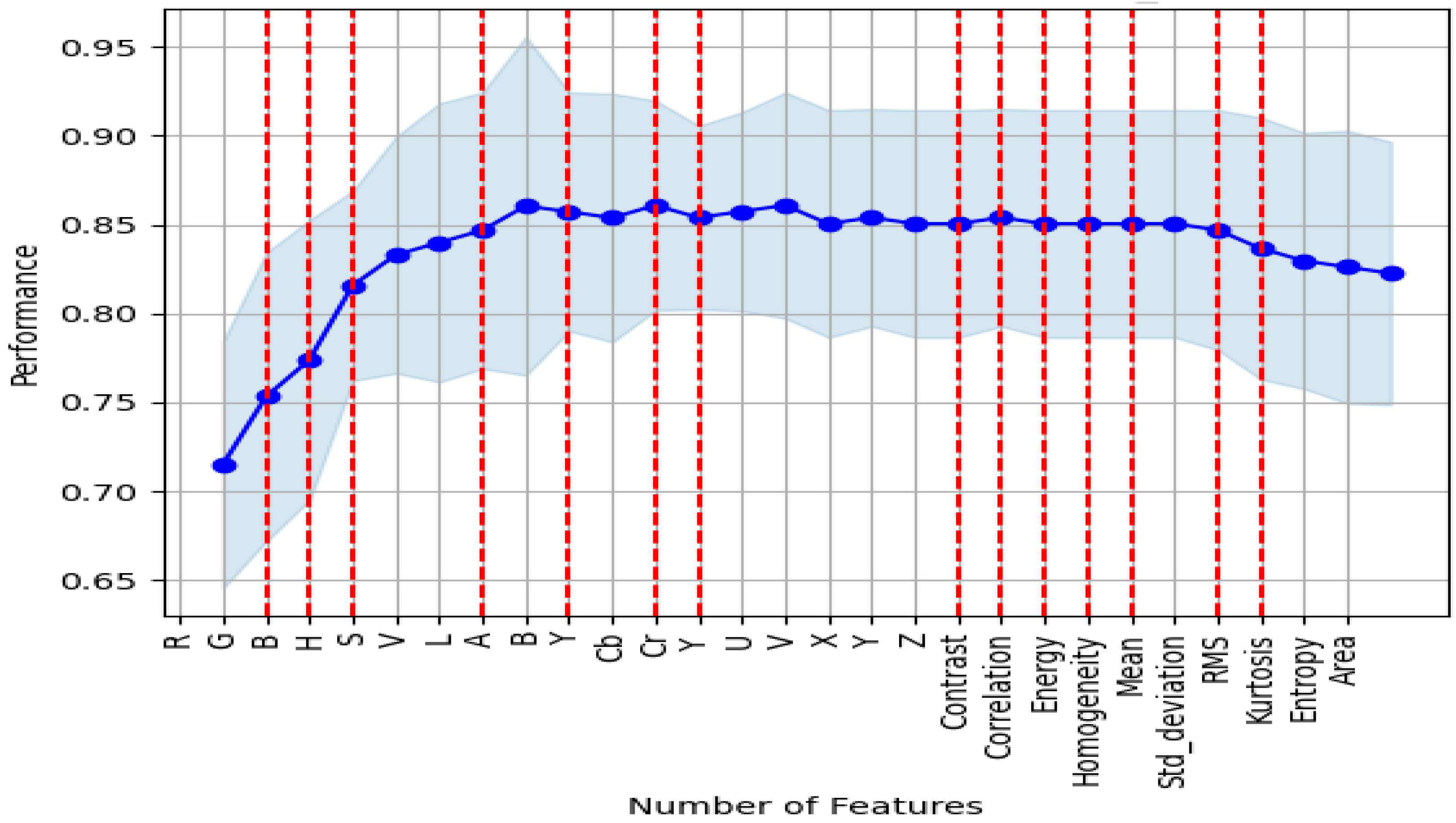
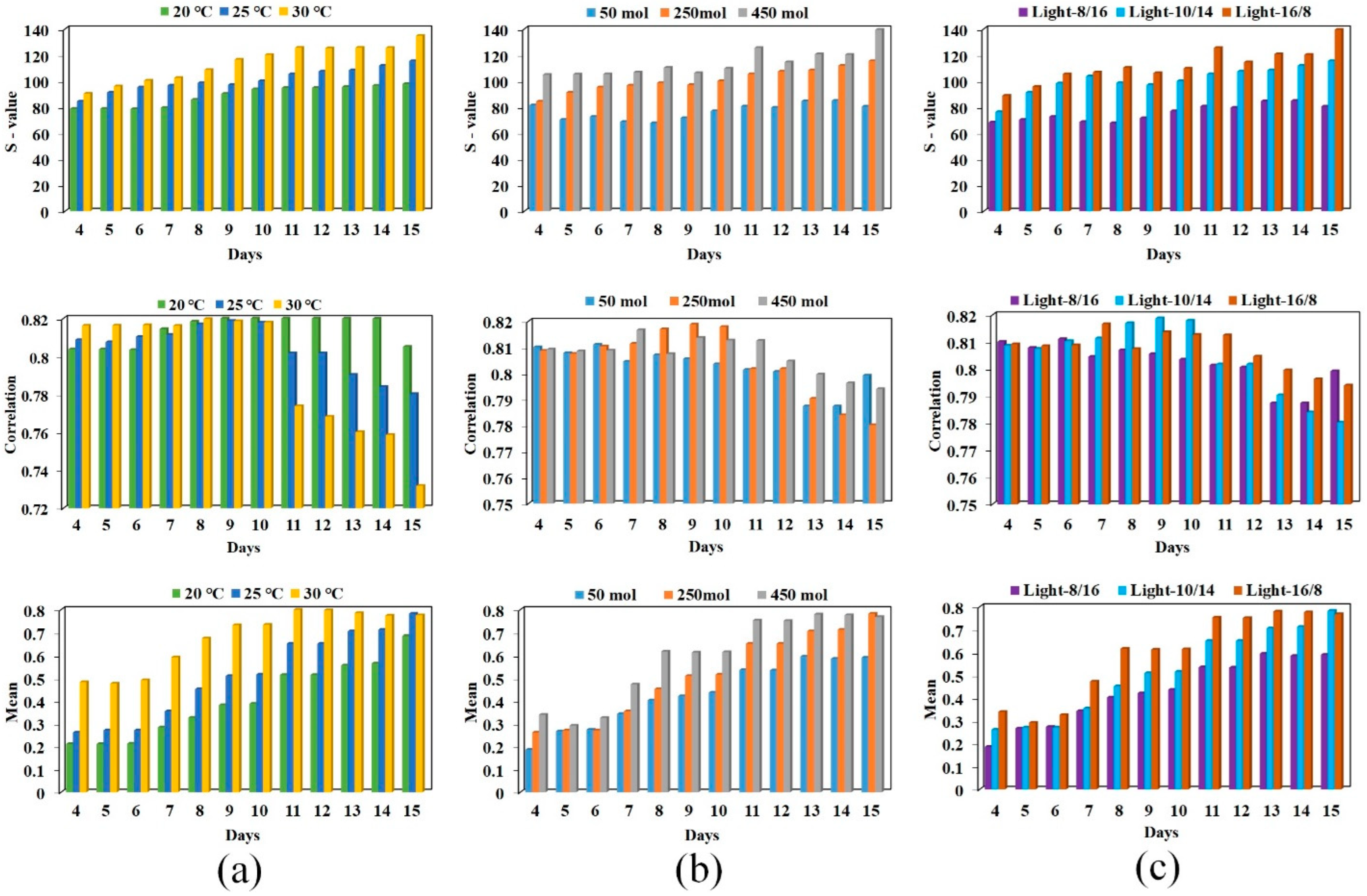
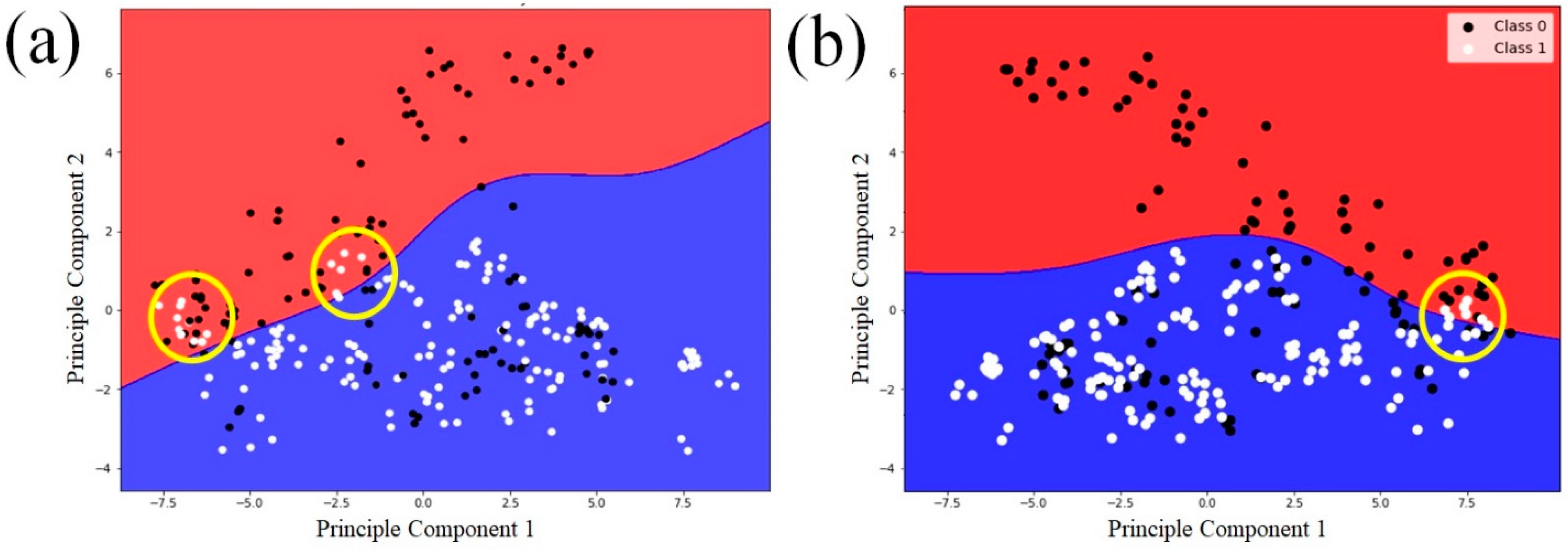

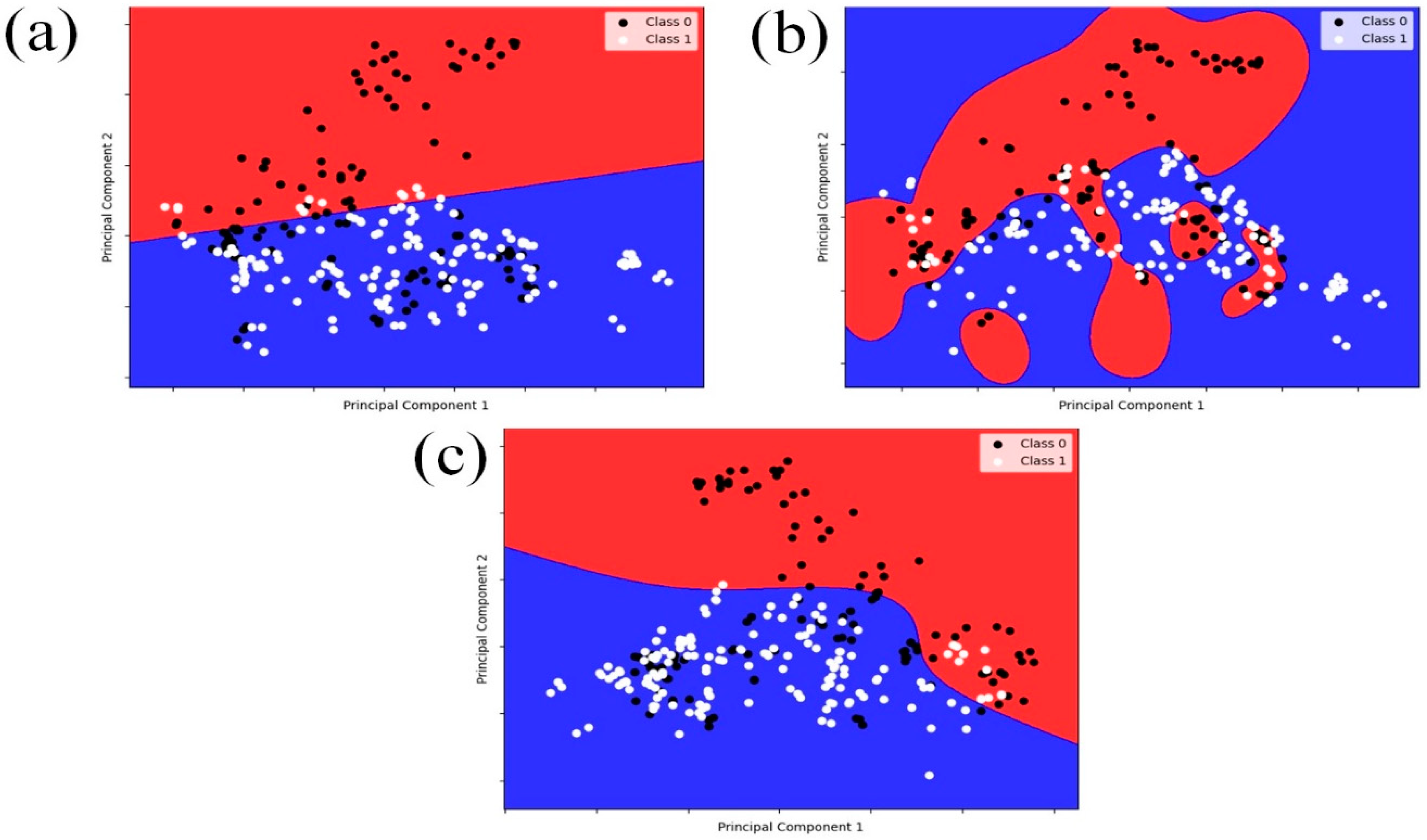
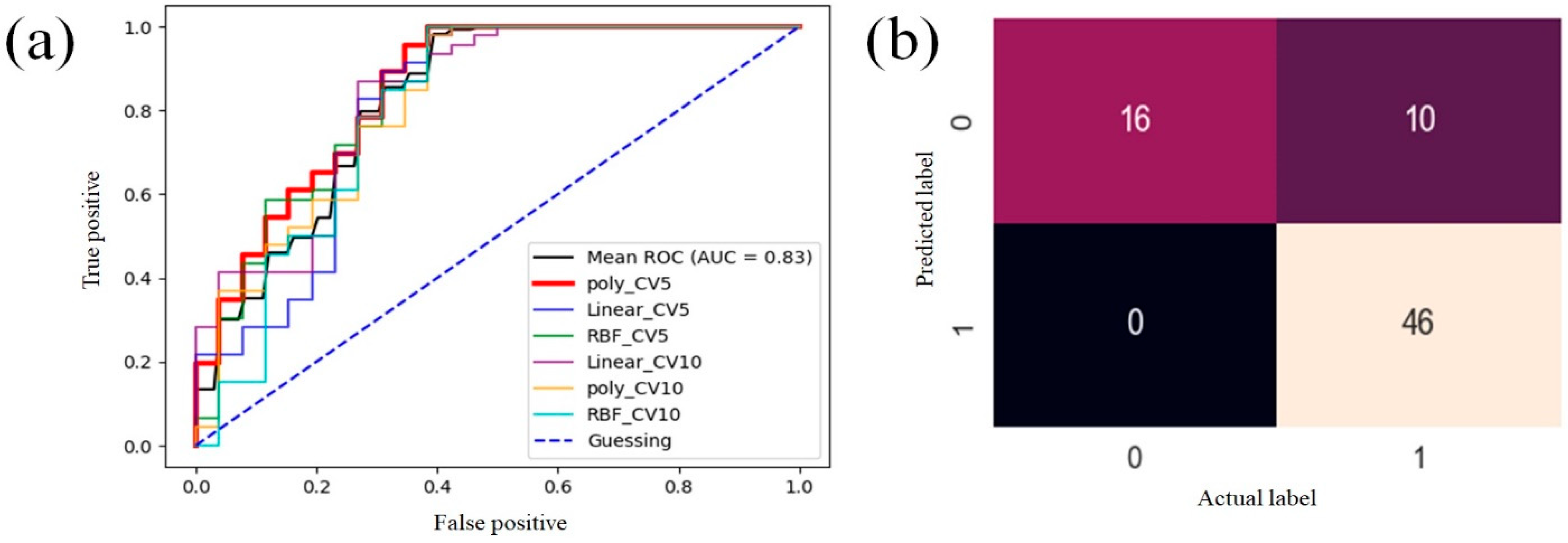
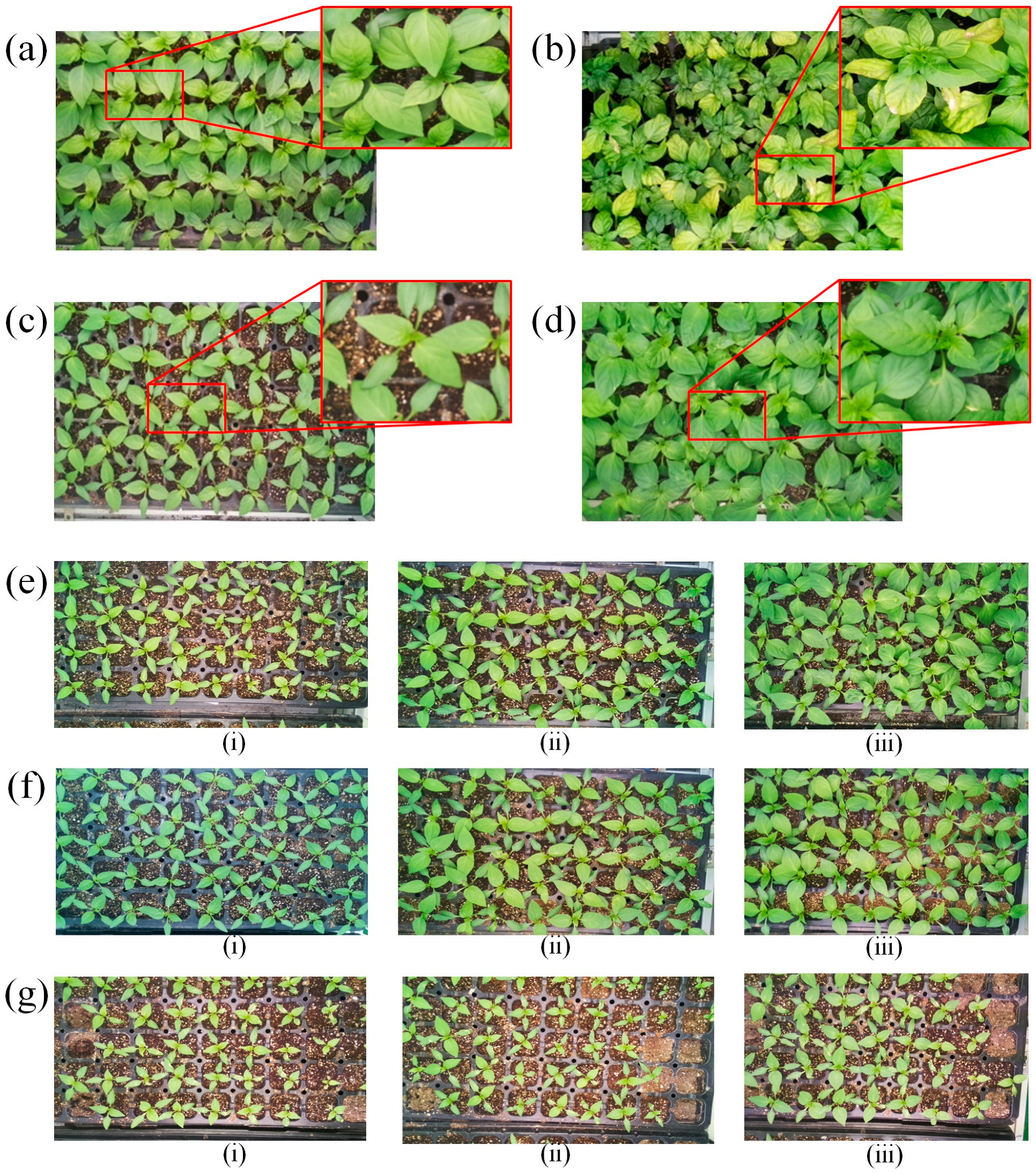
| Ambient Condition | No-Stress Condition | Stress Condition | ||
|---|---|---|---|---|
| Day (10 h) | Night (14 h) | Day (10 h) | Night (14 h) | |
| Temperature (°C) | 25 | 20 | 20 | 15 |
| Light intensity (µmol m−2s−1) | 250 | 0 | 50, 450 | 0 |
| Photoperiod (h) | 10 | 14 | 16, 8 | 8, 16 |
| Humidity (%) | 60 ± 5 | |||
| CO2 (ppm) | 600–800 | |||
| EC (dS·m−1) | 0.8 | |||
| pH | 6.0 | |||
| Air flow | Static | |||
| Light type | Fluorescent (daylight, 2900 lm) | |||
| Parameter | Sensor Model | Specification |
|---|---|---|
| Temperature Humidity | DHT22, China | Temperature range: −40–80 °C Humidity range: 0–100% Temperature accuracy: ±0.5 °C Humidity accuracy: ±2% Compatible: 3.0–5.0 V |
| CO2 | SH-300DS, SohaTech, Republic of Korea | CO2 range: 0–10,000 ppm Accuracy: ±2% Signal interval: 2 s Output: Analog: 0–3 VDC Warm up Time @25 °C: <90 s Compatible: 5.0–9.0 V |
| Light intensity | GY 30, China | Range: 1–65,535 lx Accuracy: ±20% Compatible: 3.3–5.0 V |
| EC | COM-100, HM Digital, Republic of Korea | EC Range: 0–9990 μS Temperature range: 5–80 °C EC Accuracy: ±2% Temperature Accuracy: ±1.0 °C |
| pH | SX-620, Sanxin, China | pH Range: 1–15 Temperature range: 0–60 °C pH Accuracy: ±0.01 pH Temperature Accuracy: ±1.0 °C |
| Parameter | Microcontroller | Parameter | RGB Camera |
|---|---|---|---|
| Name | Raspberry Pi 4B board | Name | Raspberry Pi Camera |
| CPU | Quad core Cortex-A72, 64-bit, 1.8GHz | Sensor | Sony IMX 219 PQ CMOS |
| RAM | 8GB LPDDR4-3200 | Resolution | 8 MP |
| Connection | Standard 40 pin GPIO header | Image resolution | 3280 × 2464 pixel |
| Operating system | Linux based | FPS | 1080p: 30; 720p: 60 |
| Power supply | 5V DC | Connection | 15-pin MIPI CSI-2 |
| Operating temperature | 0° to 50 °C | Image control | Automatic |
| A | |||||||
| Day | B_val | H_val | S_val | A_val | Y_val | Cr_val | Y_val |
| 1 | 170.98 A | 41.021 A | 71.6 A | 112.65 A | 210.96 A | 100.09 A | 210.96 A |
| 2 | 169.76 A | 41.076 A | 72.64 A | 112.51 A | 211.05 A | 99.48 A | 211.05 A |
| 3 | 171.73 A | 41.133 A | 72.05 A | 112.88 A | 211.03 A | 98.72 A | 211.03 A |
| 4 | 160.62 B | 39.836 B | 78.74 B | 111.13 B | 205.23 B | 97.34 B | 205.23 B |
| 5 | 150.62 C | 39.836 B | 78.74 B | 111.13 B | 205.28 B | 97.72 B | 205.28 B |
| Sig | 0 | 0 | 0 | 0 | 0 | 0 | 0 |
| LSD | 1.8456 | 0.7773 | 1.7813 | 2.2676 | 2.7764 | 0.5268 | 2.5931 |
| CV | 0.8 | 1.22 | 1.51 | 1.56 | 0.94 | 0.28 | 0.88 |
| Day | Contrast | Correlation | Energy | Homogeneity | Mean | RMS | Kurt |
| 1 | 0.0445 A | 0.7991 A | 0.8557 A | 0.9778 A | 0.1316 A | 0.3567 A | 4.1173 A |
| 2 | 0.0427 A | 0.7958 A | 0.8658 A | 0.9787 A | 0.119 A | 0.3446 A | 4.02 A |
| 3 | 0.0425 A | 0.7966 A | 0.8659 A | 0.9787 A | 0.119 A | 0.3446 A | 4.023 A |
| 4 | 0.0646 B | 0.8025 B | 0.7821 B | 0.9677 B | 0.2073 B | 0.4548 B | 0.3835 B |
| 5 | 0.0653 B | 0.8037 B | 0.7782 B | 0.9673 B | 0.212 B | 0.46 B | 0.2746 B |
| Sig | 0 | 0 | 0 | 0 | 0 | 0 | 0 |
| LSD | 8.94 × 10−3 | 7.49 × 10−3 | 0.0339 | 4.47 × 10−3 | 0.0447 | 0.048 | 1.4673 |
| CV | 7.93 | 0.59 | 2.97 | 0.3 | 8.16 | 5.39 | −5363.88 |
| B | |||||||
| Day | B_val | H_val | S_val | A_val | Y_val | Cr_val | Y_val |
| 1 | 161.11 A | 46.26 A | 66.171 A | 108.26 A | 201.45 A | 104.42 A | 201.95 A |
| 2 | 160.57 A | 46.14 A | 66.901 A | 109.79 A | 202.07 A | 104.8 A | 202.07 A |
| 3 | 160.57 A | 46.47 A | 66.56 A | 110.12 A | 202.41 A | 105.47 A | 202.41 A |
| 4 | 153.37 B | 49.99 B | 71.496 B | 105.64 B | 196.53 B | 100.79 B | 196.53 B |
| 5 | 153.91 B | 50.05 B | 72.27 B | 104.14 B | 194.64 B | 100.14 B | 194.64 B |
| Sig | 0 | 0 | 0 | 0 | 0 | 0 | 0 |
| LSD | 2.2165 | 1.6404 | 1.7813 | 1.5539 | 5.1327 | 1.6341 | 3.8914 |
| CV | 1 | 1.97 | 1.51 | 0.96 | 1.81 | 0.99 | 1.37 |
| Day | Contrast | Correlation | Energy | Homogeneity | Mean | RMS | Kurt |
| 1 | 0.0515 A | 0.0513 A | 0.8262 A | 0.973 A | 0.1852 A | 0.3824 A | 0.8806 A |
| 2 | 0.0584 A | 0.0584 A | 0.8186 A | 0.972 A | 0.1877 A | 0.3856 A | 0.8974 A |
| 3 | 0.0581 A | 0.0581 A | 0.8153 A | 0.9686 A | 0.1851 A | 0.3822 A | 0.8874 A |
| 4 | 0.068 B | 0.0544 B | 0.7971 B | 0.9103 B | 0.1959 B | 0.3914 B | −0.8502 B |
| 5 | 0.0745 C | 0.0545 B | 0.7361 C | 0.9039 B | 0.2078 C | 0.4265 C | −0.7202 B |
| Sig | 0 | 0 | 0 | 0 | 0 | 0 | 0 |
| LSD | 2.91 × 10−3 | 2.37 × 10−3 | 0.0184 | 4.88 × 10−3 | 0.0146 | 0.0146 | 6.44 × 10−1 |
| CV | 2.26 | 1.84 | 1.66 | 0.33 | 2.45 | 1.94 | −42.87 |
| C | |||||||
| Days | B_val | H_val | S_val | A_val | Y_val | Cr_val | Y_val |
| 1 | 151.24 A | 41.15 A | 85.00 A | 108.06 A | 202.22 A | 103.46 A | 196.97 A |
| 2 | 151.29 A | 40.49 A | 85.55 A | 110.79 A | 205.37 A | 99.17 A | 195.37 A |
| 3 | 151.91 A | 40.32 A | 85.74 A | 108.97 A | 203.95 A | 95.81 A | 195.95 A |
| 4 | 148.75 A | 41.21 B | 84.14 A | 108.67 B | 197.01 B | 97.37 B | 195.01 A |
| 5 | 149.55 B | 42.18 B | 79.14 B | 109.11 B | 200.81 B | 99.07 C | 194.02 B |
| Sig | 0 | 0 | 0 | 0 | 0 | 0 | 0 |
| LSD | 8.0216 | 1.5509 | 3.6144 | 0.9583 | 9.304 | 2.6968 | 8.8987 |
| CV | 3.81 | 2.31 | 2.7 | 0.57 | 3.23 | 1.73 | 3.11 |
| Day | Contrast | Correlation | Energy | Homogeneity | Mean | RMS | Kurt |
| 1 | 0.012 A | 0.9307 A | 0.8981 A | 0.994 A | 0.1027 A | 0.313 A | 7.2629 A |
| 2 | 0.0116 A | 0.9301 A | 0.907 A | 0.9942 A | 0.0913 A | 0.3019 A | 6.7501 A |
| 3 | 0.0117 A | 0.9303 A | 0.9037 A | 0.9942 A | 0.0949 A | 0.3077 A | 6.4417 A |
| 4 | 0.0198 B | 0.9366 B | 0.8172 B | 0.9901 B | 0.1941 B | 0.4404 B | 0.7232 B |
| 5 | 0.0192 B | 0.9375 C | 0.8214 B | 0.9904 C | 0.189 B | 0.4346 B | 0.8473 B |
| Sig | 0 | 0 | 0 | 0 | 0 | 0 | 0 |
| LSD | 0.002225 | 0.004687 | 0.0296 | 0.001112 | 0.0627 | 0.0601 | 2.2189 |
| CV | 7.54 | 0.32 | 2.43 | 0.07 | 13.31 | 7.31 | 175.1 |
| Parameter | SVM Classification with SFS Method | SVM Classification without SFS Method | ||||||
|---|---|---|---|---|---|---|---|---|
| Precision | Recall | F1 Score | Support | Precision | Recall | F1 Score | Support | |
| Non-stressed (0) | 1.00 | 0.62 | 0.76 | 26 | 0.90 | 0.56 | 0.69 | 32 |
| Stressed (1) | 0.82 | 1.00 | 0.90 | 46 | 0.80 | 0.97 | 0.88 | 58 |
| Accuracy | 0.86 | 72 | 0.82 | 90 | ||||
| Macro avg. | 0.91 | 0.81 | 0.83 | 72 | 0.85 | 0.76 | 0.78 | 90 |
| Weighted avg. | 0.89 | 0.86 | 0.85 | 72 | 0.84 | 0.82 | 0.81 | 90 |
| Parameter | SVM Classification with Linear Kernel | SVM Classification with Polynomial Kernel | SVM Classification with RBF Kernel | |||||||||
|---|---|---|---|---|---|---|---|---|---|---|---|---|
| Precision | Recall | F1 Score | Support | Precision | Recall | F1 Score | Support | Precision | Recall | F1 Score | Support | |
| Non-stressed (0) | 0.77 | 0.69 | 0.71 | 26 | 1.00 | 0.62 | 0.76 | 26 | 0.75 | 0.69 | 0.72 | 26 |
| Stressed (1) | 0.82 | 0.89 | 0.85 | 46 | 0.82 | 1.00 | 0.90 | 46 | 0.83 | 0.87 | 0.85 | 46 |
| Accuracy | 0.81 | 72 | 0.86 | 72 | 0.81 | 72 | ||||||
| Macro avg. | 0.80 | 0.77 | 0.78 | 72 | 0.91 | 0.81 | 0.83 | 72 | 0.79 | 0.78 | 0.79 | 72 |
| Weighted avg. | 0.80 | 0.81 | 0.80 | 72 | 0.89 | 0.86 | 0.85 | 72 | 0.80 | 0.81 | 0.80 | 72 |
| Parameter | SVM Classification with Linear Kernel | SVM Classification with Polynomial Kernel | SVM Classification with RBF Kernel | |||||||||
|---|---|---|---|---|---|---|---|---|---|---|---|---|
| Precision | Recall | F1 Score | Support | Precision | Recall | F1 Score | Support | Precision | Recall | F1 Score | Support | |
| Non-stressed (0) | 0.76 | 0.62 | 0.68 | 26 | 0.94 | 0.62 | 0.74 | 26 | 0.67 | 0.85 | 0.75 | 26 |
| Stressed (1) | 0.80 | 0.89 | 0.85 | 46 | 0.82 | 0.98 | 0.89 | 46 | 0.90 | 0.76 | 0.82 | 46 |
| Accuracy | 0.79 | 72 | 0.85 | 72 | 0.79 | 72 | ||||||
| Macro avg. | 0.78 | 0.75 | 0.76 | 72 | 0.88 | 0.80 | 0.82 | 72 | 0.78 | 0.80 | 0.78 | 72 |
| Weighted avg. | 0.79 | 0.79 | 0.79 | 72 | 0.86 | 0.85 | 0.84 | 72 | 0.81 | 0.79 | 0.80 | 72 |
| Kernel Type | Cross-Validations (CVs) | C, γ | MAE | Precision | Recall | F1-Score | Accuracy (%) | Processing Time (s) |
|---|---|---|---|---|---|---|---|---|
| Polynomial | 5 | C = 500 γ = auto | 0.138 | 0.91 | 0.86 | 0.83 | 86% | 1945 |
| Polynomial | 10 | C = 500 γ = auto | 0.177 | 0.85 | 0.82 | 0.78 | 82% | 2030 |
| Linear | 5 | C = 500 | 0.19 | 0.80 | 0.81 | 0.78 | 81% | 1780 |
| Linear | 10 | C = 128 | 0.22 | 0.78 | 0.79 | 0.76 | 79% | 1820 |
| RBF | 5 | C = 500 γ = 1024 | 0.18 | 0.79 | 0.81 | 0.79 | 81% | 2583 |
| RBF | 10 | C = 128 γ = 128 | 0.21 | 0.78 | 0.80 | 0.78 | 79% | 2690 |
| Polynomial | 5 | C = 128 γ = 0 | 0.21 | 0.91 | 0.86 | 0.83 | 86% | 1880 |
| Polynomial | 10 | C = 128 γ = 0 | 0.163 | 0.88 | 0.85 | 0.82 | 85% | 1910 |
| Model | Accuracy (%) |
|---|---|
| Artificial Neural Network (ANN) [63] | 84.4% |
| Convolutional Neural Network (CNN) [64] | 95.61 |
| k-Nearest Neighbors [65] | 83.5 |
| Support Vector Machine (SVM) [65] | 79.2 |
| Naive Bayes [66] | 88.3 |
| Probabilistic Neural Network (PNN) [67] | 87–89% |
| Support Vector Machine (SVM) [67] | 87–89% |
| Our model | 79–86% |
Disclaimer/Publisher’s Note: The statements, opinions and data contained in all publications are solely those of the individual author(s) and contributor(s) and not of MDPI and/or the editor(s). MDPI and/or the editor(s) disclaim responsibility for any injury to people or property resulting from any ideas, methods, instructions or products referred to in the content. |
© 2024 by the authors. Licensee MDPI, Basel, Switzerland. This article is an open access article distributed under the terms and conditions of the Creative Commons Attribution (CC BY) license (https://creativecommons.org/licenses/by/4.0/).
Share and Cite
Islam, S.; Samsuzzaman; Reza, M.N.; Lee, K.-H.; Ahmed, S.; Cho, Y.J.; Noh, D.H.; Chung, S.-O. Image Processing and Support Vector Machine (SVM) for Classifying Environmental Stress Symptoms of Pepper Seedlings Grown in a Plant Factory. Agronomy 2024, 14, 2043. https://doi.org/10.3390/agronomy14092043
Islam S, Samsuzzaman, Reza MN, Lee K-H, Ahmed S, Cho YJ, Noh DH, Chung S-O. Image Processing and Support Vector Machine (SVM) for Classifying Environmental Stress Symptoms of Pepper Seedlings Grown in a Plant Factory. Agronomy. 2024; 14(9):2043. https://doi.org/10.3390/agronomy14092043
Chicago/Turabian StyleIslam, Sumaiya, Samsuzzaman, Md Nasim Reza, Kyu-Ho Lee, Shahriar Ahmed, Yeon Jin Cho, Dong Hee Noh, and Sun-Ok Chung. 2024. "Image Processing and Support Vector Machine (SVM) for Classifying Environmental Stress Symptoms of Pepper Seedlings Grown in a Plant Factory" Agronomy 14, no. 9: 2043. https://doi.org/10.3390/agronomy14092043
APA StyleIslam, S., Samsuzzaman, Reza, M. N., Lee, K.-H., Ahmed, S., Cho, Y. J., Noh, D. H., & Chung, S.-O. (2024). Image Processing and Support Vector Machine (SVM) for Classifying Environmental Stress Symptoms of Pepper Seedlings Grown in a Plant Factory. Agronomy, 14(9), 2043. https://doi.org/10.3390/agronomy14092043










